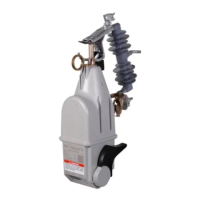S&C Instruction Sheet 461-504 127
Appendix C
Available Screens to Be Added to the “Display” Screen Sequence
Screen Name Description
Static or
Dynamic
(when operating
in the field)
— Hold Previous
Screen
The previous screen selected in the sequence is displayed for an additional
period of time as defined by the Each “Display” Screen Duration setpoint.
—
Blue Screen A blue screen is displayed. When the Identify command is given by the
communications gateway, the LCD screen will update to all blue, then all
white, and repeat. This can help to identify a specific TripSaver II recloser.
Static
Primary Normal
Screen
Four operating parameters are displayed: Vacuum Interrupter status (Open
or Closed); Mode Selector status (Auto or NR), Overload indicator at the
bottom left corner (Symbol “X”), and Service Soon indicator at the bottom
right corner (Symbol “•”). The Overload indicator will appear when the
TripSaver II recloser has dropped open because of an overload. The Service
Soon indicator will appear when the vacuum interrupter reaches 10% of the
remaining contact wear.
For Extended Open Interval option-enabled TripSaver II reclosers (catalog
number with “-O” suffix option), an additional operating parameter may be
displayed: Battery Status indicator (Symbol “!”) to the left of the Service
Soon indicator. The Battery Status indicator will appear when the control
detects a battery problem.
Dynamic
Secondary Normal
Screen
Three operating parameters are displayed: Vacuum Interrupter status at
the upper left corner (Symbol “O” for open, Symbol “I” for closed), Number of
Open operations at the upper right corner, and Remaining Contact Wear in
bar chart format at the bottom of the screen. (A full blue bar indicates 100%
remaining contact wear. The blue bar shortens in length leftward as
remaining contact wear decreases.)
Dynamic
Load Current The load current in primary amperes is displayed. Dynamic
Last Fault Magnitude The fundamental-frequency magnitude of the last fault current in primary
amperes, measured just prior to the opening of the vacuum interrupter, is
displayed. The fault current unit is A for faults smaller than 1000 A, and
kA with two decimals for faults greater or equal to 1000 A. This was done
because of the limited horizontal space on the LCD screen
Dynamic
Vacuum Interrupter
Status
The state of the vacuum interrupter–either “Open” or “Closed”–is displayed. Dynamic
TABLE CONTINUED ▶

